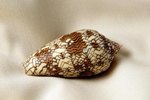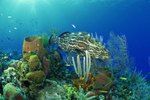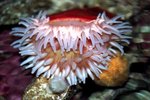
Sea anemones and sea urchins can be found at all depths throughout the world's oceans. Nearly 7000 different species of anemones and 1000 urchin species exist. Both prefer to live on the ocean floor or coral reefs, although a few exceptions occur. Other than environmental location, these two animals differ greatly. They each have their own physical characteristics and environmental relationships.
Appearances
Sea anemones are classified as Cnidaria. They are soft-bodied, simple animals that remain primarily sedentary, resembling flowers in appearance. Anemone size can range from a few millimeters to a diameter of 1.5 meters. Sea urchins -- Echinoidea -- have a hard shell of calcium carbonate covered by skin and long movable spines. The urchin's round body has five-part radial symmetry with pores containing tubular feet between each section.
Toxins and Venom
All anemones possess toxins, while only some urchins possess venom. Sea anemones have stinging capsules present on their tentacles. The capsules contain a paralyzing neurotoxin that is injected into any small fish or animal that stumbles into the tentacles. The tentacles bring the paralyzed food to a central cavity for digestion. Urchins use their spines as protection. Along with being painfully sharp, some urchins have tiny venomous pincers called pedicillariae.
Digestive Physiology
The anemones have one body cavity that performs digestion, nutrient absorption and gas exchange. The body cavity opens in the center at the top of the anemone. Urchins have a simple digestive system with a mouth on the underside that contains a dental apparatus used to scrape algae and food from rocks. The food moves into a stomach, through the intestine and into the anus, which is on the top surface of the animal.
Reproduction
Most sea anemones release sperm and eggs into the water, where fertilization occurs. The eggs develop into larvae and disperse to new areas before becoming adults. Certain anemones, such as Anemonia and Metridium reproduce asexually by dividing or fragmenting. Reproduction for sea urchins is similar. Whole populations release sperm and eggs into the water at the same time. The eggs develop into larvae and migrate to the water surface where, after several weeks, they develop a rudiment. The rudiment slowly develops into an adult urchin and sinks to the ocean floor.
Behavioral Adaptations

Several adaptive and symbiotic behaviors have been implemented by sea anemones and sea urchins. Sea anemones often live together with hermit crabs, fish or green algae. The anemones benefit from the mobility of the hermit crabs, scraps provided by a fish's meal or oxygen from the algae. Certain anemones secrete mucous to which sand, shells and foreign objects become attached, thus providing protection and camouflage. Additionally, urchins often place a variety of objects on their backs to protect themselves from sunlight and provide camouflage.
References
- National Geographic: Sea Anemone
- Encyclopedia Britannica: Sea Anemone
- Marine Education Society of Australasia: Echinoderms
- Encyclopedia Britannica: Echinoderm
- Encyclopedia Britannica: Sea Urchin
- University of Utah: Introduction to Dive Medicine, Dangerous Creatures of the Sea
- University of Kansas: Illustrated Glossary of Sea Anemone Anatomy
- National History Museum: The Echinoid Directory, Reproduction and Life History
Photo Credits
-
Comstock Images/Comstock/Getty Images
Writer Bio
Based in Michigan, Keri Gardner has been writing scientific journal articles since 1998. Her articles have appeared in such journals as "Disability and Rehabilitation" and "Journal of Orthopaedic Research." She holds a Master of Science in comparative medicine and integrative biology from Michigan State University.




